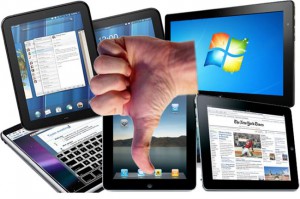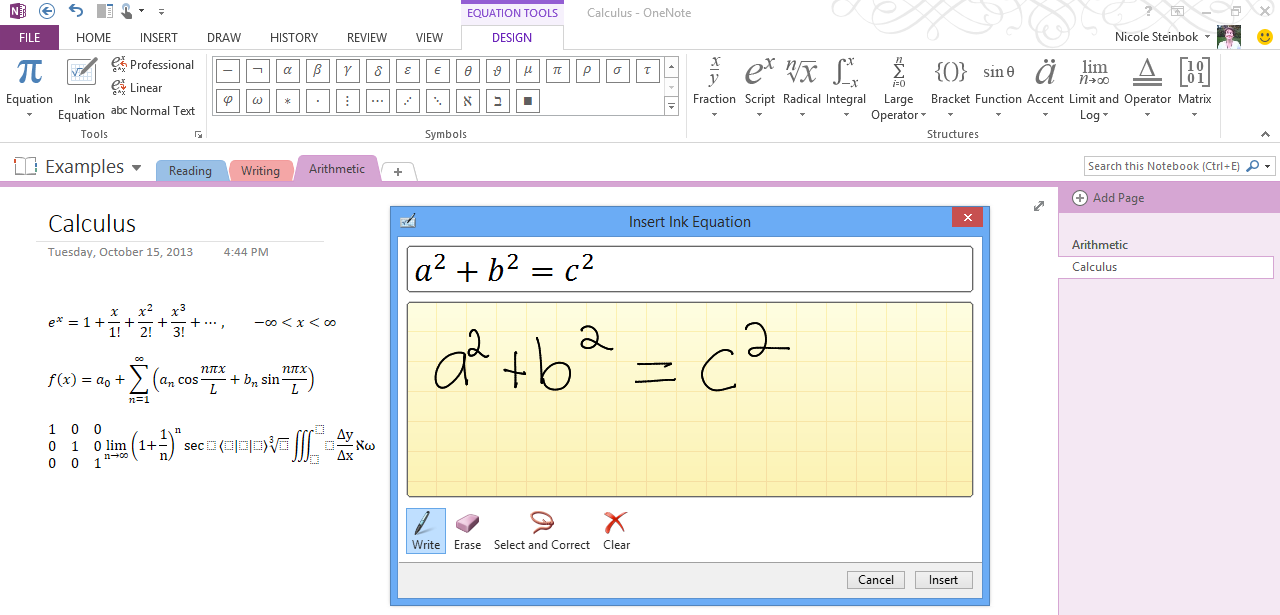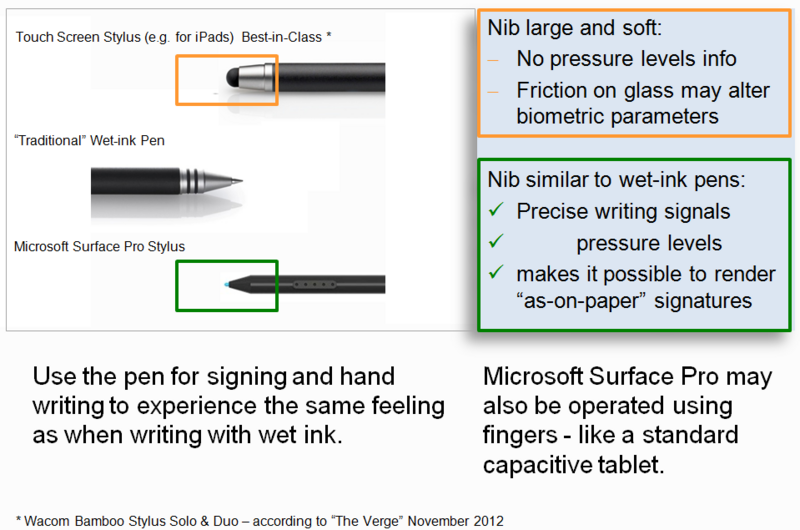Why tablets are failing miserably in higher education
 While Apple and Google are fighting a FUD war for the hearts and minds of K-12 campuses, there's one area of education that neither has been able to penetrate with success: higher ed. Specifically, I'm referring to the conglomerate of colleges and universities across the US (and likely abroad).
While Apple and Google are fighting a FUD war for the hearts and minds of K-12 campuses, there's one area of education that neither has been able to penetrate with success: higher ed. Specifically, I'm referring to the conglomerate of colleges and universities across the US (and likely abroad).
That's because for all their love in the media, tablets have yet to prove their weight when it comes to deep research and content manipulation in the classroom. Real student work comes in the form of content creation, not consumption -- an area Google and Apple are endlessly infatuated with.
To this end, I wasn't entirely shocked to see Computerworld publish a story that questioned whether iPads were making the grade on campuses today. The article featured some numbers from a long running survey by Ball State's Institute for Mobile Media Research which found that, according to the latest figures, only 29 percent of students own a tablet today.
Advertising professor and director of the above institute, Michael Hanley, called tablets out similarly to how I've done numerous times before: "Tablets are for entertainment purposes, not for writing papers and doing class projects -- key components of higher education".
He went on to say that, "Tablets are fine for reading material and accessing digital files, but for any type of coursework requiring sophisticated design, image manipulation or production, tablets fall far short. Of the 140 students in my classes this year, none used a tablet in class for academic purposes".
This trend of college students thumbing their noses at tablets has been reported in other studies as well. Deloitte found that overwhelming majorities of college kids today own computers and smartphones (more than 80 percent for each category, in fact) and tablets are considered redundant for what they offer.
Louis Ramirez, of Dealnews.com, summed it up rather well. "Unless you’re shooting for a degree in Angry Birds, tablets are a horrible back-to-school purchase. You can’t write a 10-page research paper with an iPad".
The Traditional Tablet Dilemma in the Classroom
I didn't need formal study figures to come up with my own conclusions based on personal experience. In between my busy days working with customers, I'm actually a student myself once again. While most of my graduate school classes are taken online from the comfort of home, I do opt to take some of the tougher classes (like math-driven ones) in a traditional manner. Today's webcasting software, which lets me watch class recordings, isn't up to the levels of what we consider normal on, say, YouTube or over Lync, but that's a gripe for another day.
Nevertheless, I had the chance to take a rigorous financial planning course in-person aimed at IT professionals a few quarters back. The class consisted of about 15-20 people on a weekly basis. Of those, I would say about 50 percent chose to use some kind of digital device to "assist" during the course of note taking. Me being one of them.
Of that 50 percent, I would say that well less than half were on iPads; the rest had laptops or hybrids. I saw one Surface Pro user happily using OneNote, and I joined him with my Thinkpad X230 Tablet in slate mode. No complaints there.

It's no surprise that traditional tablets are failing to gain critical mass on college campuses. Studies continue to prove what has been belief for years already: that non-convertible tablets like the iPad are a complete nonstarter when anything more than rudimentary text or data entry is required. Until more tablet makers realize their shortcomings, and move in the direction of the Surface with keyboard/mouse input, tablets will be taking a backseat to laptops for the indefinite future. (Image Source: SurfPK)
But what were the iPad users doing during class? Besides fumbling around in Facebook or the web browser, the few that actually used the device for some purpose related to class merely had copies of the PowerPoint slides opened on their tablets. In essence, they sat there and thumbed through the same exact thing that was being shown on the projector. An interesting approach to dual screen functionality, I'd say.
I will be honest and admit that one individual attempted to take typed notes into his iPad (from a third party keyboard) but after trudging along in this manner and trying to keep up with the complex equations the professor was displaying, he gave up. The paper notebook came out and the iPad didn't show up again.
It was rather interesting to sit by and watch, as both a fellow student and observer. All the while, I had no qualms about taking snippets of the PPT slides and inserting them into my OneNote notebook. I had the freedom and flexibility of what a traditional notebook affords, with the digital organization and powerful search that OneNote brings to the table.
I'm not here to pitch the benefits of OneNote. The program sells itself in my eyes. I was just surprised that a company with as many big ideas and consumers wins over the last decade as Apple, still hasn't figured out what serious education users are looking for in a device.
I admit my Thinkpad X230T won't win any fashion awards compared to an iPad or Surface Pro. But it got a heck of a job done where I personally watched the iPad crumble into performing the simplest tasks any computer could replicate with ease: viewing PPT slides with no contextual notetaking input.
And college isn't the only place I've seen iPads have a tough time. When I used to work IT for a public high school district in Illinois, I was knee deep in watching segments of our own district and other nearby districts attempt their hand at traditional tablets. From the nightmares of managing these devices, to students and educators who were constantly fighting the limitations of the platforms, I was perplexed at why no one ever took a step back to ask: is this really the direction we should be heading?
Needless to say, my former employer made a smart move and adopted Chromebooks district-wide, but the voices pushing them in the iPad direction were strong and unrelenting. I still think going Surface would have been a step up, but the cost of these devices is admittedly a premium for a taxpayer-funded, high school environment.
I'm sure I can't be alone in my observations. If the numbers above hold their own, then tablets in their most traditional form are missing the grade in higher education rather miserably.
Consumption-Focused Tablets Provide Little Value for Higher Ed
Apple and Google continue to count their app store ecosystem titles by the thousands, and yet they fail to realize this has little relevance on the college campus today. The younger generation enrolled at universities and colleges are well aware that if they are going to choose a device upon which to spend countless hours upon, it very well should be one that is versatile for both the classroom and the dorm room.
The iPads, Nexus, and Xooms of the world are elegant and crafty electronics platforms for watching Netflix, browsing Facebook, and perhaps tuning into Pandora. But where they excel in consumption minded activities, they are merely along for the ride when it comes complex content creation.
I urge you to spare me the mentions of all the third party input devices for the iPad like keyboards and complex, battery driven add-on covers that aim to fill this gap. I'll put it very succinctly: if Apple wanted to be serious about tablets in the higher education sphere, they would have taken similar steps as the Surface Pro already has. I bet a large part of their hesitation is that they can't stimy Macbook sales any further for fear of pushing their own laptops into irrelevancy. I see the business acumen behind it, but for those who really want to replace their laptop with an iPad, they couldn't care less.
Even the launch of Office for iPad doesn't solve many of the innate roadblocks that finger-input-only tablets present, like the lack of mousing ability to rearrange content en-masse easily, manipulate groupings of cells in Excel, or even cut and paste items between PowerPoint slides. While Office for iPad was written with finger limitations in mind, almost two months after its launch, I have yet to encounter any iPad-toting clients who have opted to ditch their primary computer.

The amount of intimacy that a digitized stylus tablet provides is truly unrealized until you give one a try yourself. From easily converting complex drawn-out equations (shown above) to allowing for instant searchability for handwritten notes, modern tools like OneNote 2013 on Windows 8.1 make the iPad version look like child's play. I'd be hard pressed to find many that wouldn't fall in love with a digitized stylus device over an iPad after trying it for themselves. (Image Source: OneNote Blog)
Most honest document-warriors (business pros and higher ed students alike) see traditional tablets for what they really are: complementary devices -- not full laptop replacements in any way. The Surface Pro is the first true tablet hybrid that fits both bills equally well, and many colleges are choosing this route over the iPad in larger numbers each year.
Tom Grissom (Ph.D.) published a lengthy writeup on his education-focused foray into usage of Surface Pro at Eastern Illinois University, and summed it up pretty well: "The Surface Pro is what the iPad should have been". The rest of the writeup is a very intriguing look into how an inking-capable tablet like the Surface Pro can really be embedded into a high stakes learning environment. It's definitely a recommended read for any University or K-12 administrator interested in honest insight on what direction their campus or district should head with tablets.
I understand very well that the iPad grew to be a hit around its ease of use when it comes to slurping up content, from games to movies to web browsing. But this absolutely doesn't translate into a classroom-friendly device that empowers students in higher education to dump their computers.
As the numbers above prove, college students continue to entrust their last-generation laptops with most campus tasks still. And until other tablet makers realize their fumbles, most devices (other than exceptions like the Surface Pro) will be relegated as stocking stuffers post-graduation.
The key argument against tablets still stands: a laptop can do everything a tablet can, but not the other way around. So why would college students invest in three devices (laptop, smartphone, tablet) when two suffice just fine?
How Digitized, Hybrid Tablets Work Where the iPad Fails
Students are saying traditional tablets don't fit their needs for data-driven coursework.
Professors are saying these devices also lack the critical intimacy that can only be replicated by convertibles with true inking and traditional input (mouse/keyboard).
Are these users missing the point of regular tablets? Or are they uncovering a glaring hole with what traditional tablets bring to the table? I'm led to believe the latter is increasingly holding true.
As a graduate student right now, and a former recent undergrad student, I've been heavily reliant on a more traditional tablet PC (you know, the ones we wrote off in the late 2000s?) for my studies. Previously, a Thinkpad X41 Tablet and now my day to day X230 Tablet which doubles as my primary work PC. The only downside to these devices is the extra heft they bring and the good-but-not-great battery life. But they have all the ports I could want, and most importantly, offer me access to full OneNote with digitized stylus input -- the coup de grâce for a tablet that will succeed in an educational setting.
Without a digitized stylus screen, tablets are, in the succinct words of Shark Tank's Kevin O'Leary, "Dead to me".
When is the last time you tried to take serious notes on an iPad where there was a need to not only input text, but also complex charts and figures that were being drawn on a whiteboard? You probably haven't.
As I exemplified with my own tribulations in an IT finance course at DePaul, the iPad was never designed for such situations. No one in their right mind is going to try and "finger paint" charts and graphs with much detail or ease. And copying/pasting content from other sources into pages for markup? If you've got time to burn, go right ahead and folly around -- but I can get these same tasks done in less than a quarter of the time on my Thinkpad X230 with a digitized stylus. And the end results look great.
A similar argument can be made for the ability to use a traditional keyboard and mouse with a tablet. Look at any of the reports from campuses that decided to go Surface over iPad and the arguments are similar time and time again. Keyboard capability. Mouse input. Digitized stylus. USB ports. And the benefits go on.

For the uninitiated, there are two primary types of styli for tablets today. Most tablets without a Wacom digitizer, like an iPad or Surface RT, use a "soft touch" stylus which is nothing more than a more precise imitation of a regular human finger. It takes messy notes and has little precision advantage over a regular finger. Devices like the Surface Pro and Thinkpad X230T contain a Wacom digitizer which enables for fine-point styli to be used which are FAR better for any kind of note taking, drawing, signing, and other activities where detail and "pen-like" capability is key. I would never buy an iPad since a digitized convertible tablet with OneNote 2013 has spoiled me. (Image Source: SoftPro.de)
I know very well hell would freeze over before Apple would consider admitting defeat and opt to really turn the iPad from a toy into a purpose-driven work and school device. But this is a long shot. It's a shame, though, because if it weren't for Apple's stoic stance in the computing area it revolutionized, perhaps it could go after these segments of society which have clearly said no to their novel device.
Until that time comes, I see higher education flocking closer to alternative choices like the noteworthy Surface Pro 2 which give them everything they are looking for.
Tom Grissom, who I mentioned earlier, ran a full fledged 30 day trial on the Surface Pro as his primary educational tool in the college classroom. "I think I have demonstrated over the past 30 days that the Surface Pro is a fantastic choice for teachers, students, and others that want a full-featured tablet device with few compromises".
Instead of continuing to try and put the square peg in the round hole with iPads, I'm hoping others in education will start seeing the benefits that digitized stylus and traditional mouse/keyboard input can offer in the modern, connected classroom.
In the end, it's not about the device in your hand -- it's about the experience it provides.
If we could get over that mental roadblock, education could start getting serious about the 21st century classroom, and stop wasting money at computing approaches that just don't provide classroom value.
 Derrick Wlodarz is an IT Specialist who owns Park Ridge, IL (USA) based technology consulting & service company FireLogic, with over eight+ years of IT experience in the private and public sectors. He holds numerous technical credentials from Microsoft, Google, and CompTIA and specializes in consulting customers on growing hot technologies such as Office 365, Google Apps, cloud-hosted VoIP, among others. Derrick is an active member of CompTIA's Subject Matter Expert Technical Advisory Council that shapes the future of CompTIA exams across the world. You can reach him at derrick at wlodarz dot net
Derrick Wlodarz is an IT Specialist who owns Park Ridge, IL (USA) based technology consulting & service company FireLogic, with over eight+ years of IT experience in the private and public sectors. He holds numerous technical credentials from Microsoft, Google, and CompTIA and specializes in consulting customers on growing hot technologies such as Office 365, Google Apps, cloud-hosted VoIP, among others. Derrick is an active member of CompTIA's Subject Matter Expert Technical Advisory Council that shapes the future of CompTIA exams across the world. You can reach him at derrick at wlodarz dot net
